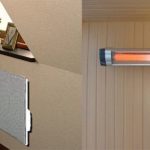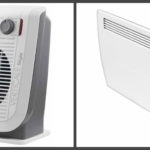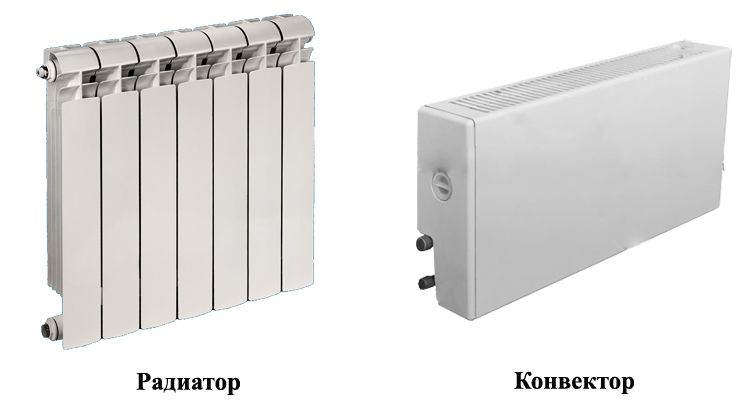What is better: micathermic heater or convector
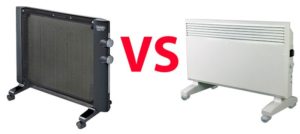 Autonomous or centralized stationary heating systems are not always able to provide sufficient heating of the room. This applies to industrial and public premises, offices, and retail outlets. The developments of various industrial climate control equipment used can improve this situation.
Autonomous or centralized stationary heating systems are not always able to provide sufficient heating of the room. This applies to industrial and public premises, offices, and retail outlets. The developments of various industrial climate control equipment used can improve this situation.
If we talk about residential premises, then the consumer needs a compact device, with low energy consumption and high efficiency - equipment that can warm up the expected volume of air inside the room and ensure uniform maintenance of the set and achieved temperature. Safety during operation in any mode is also an important detail when choosing equipment.
The content of the article
What is a micathermic heater?
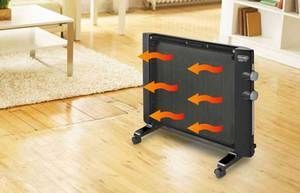 The main difference between a micathermic heater is the design of the heating element. The substrate, or base for attaching the heating element directly, is made by pressing a mixture of micanite and a heat-resistant binder. The shape and configuration of the base may vary.
The main difference between a micathermic heater is the design of the heating element. The substrate, or base for attaching the heating element directly, is made by pressing a mixture of micanite and a heat-resistant binder. The shape and configuration of the base may vary.
REFERENCE! Micanite (mica paper) are thin, flat particles of mica. Acts as a dielectric and has high thermal conductivity and thermal conductivity.
A nichrome spiral, solid nickel plates with an external coating (oxidized alloy of tin, zinc, iron), with leads for connection, can be attached to the substrate. The outer layer is a thin layer of micanite covering the heating elements, on which the concentrator and reflector of infrared radiation are mounted, and another layer of mica paper is applied on top of them. To create additional rigidity of the structure and increase the efficiency of heat transfer, it is possible to install an additional element, an aluminum plate.
ATTENTION! You should not try to improve the design of the emitter yourself. The slightest changes in the design of reflectors or outer layers of micanite lead to failure of the device.
Each developer and manufacturer prefers not to reveal all the secrets of producing these elements. But research shows that most of the proposed models are simultaneously sources of infrared radiation and heating elements.
The heating function is based on the ability of infrared waves to penetrate to a certain depth (depending on the material) of the surface of objects encountered along the path of their propagation. The energy of the waves helps to increase the temperature of these objects, from which, according to physical laws, the surrounding air space of the room is heated.
The metal housing with diffusion holes is practically no obstacle to the passage of waves. The inside of the housing has a heat-insulating coating. This is necessary due to the high temperature of the heating element emitter itself (up to 400ºC). Thanks to additional insulation, the temperature of the heater body does not exceed 50–60ºC, which prevents the possibility of accidental thermal burns.The housing can have floor and wall design options.
Advantages and disadvantages
The advantage of using micathermic heaters is:
- the ability to quickly achieve maximum power (operating mode);
- noiselessness;
- compactness;
- light weight.
In addition to this, the operation of the heater does not affect the humidity inside the room. The disadvantages include the appearance of odor during operation - due to the burning of dust that gets on the plates and a small heating area - the device heats only the area it is aimed at.
What is a convector
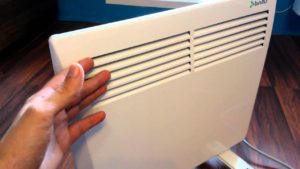 The operating principle of this type of electric heaters is based on the properties of physics and aerodynamics. Warm air is lighter than cold air and its flow is always directed upward. The rarefied space is filled with cold air. The convector facilitates this process.
The operating principle of this type of electric heaters is based on the properties of physics and aerodynamics. Warm air is lighter than cold air and its flow is always directed upward. The rarefied space is filled with cold air. The convector facilitates this process.
The convector design consists of an electric heating element (spiral, plates) mounted in the housing. The housing has intake openings or louvres of various configurations, located in the lower part of the device, and outlets for the exit of the heated air flow. The heating temperature of the air passing through the heating element or along the heating element depends on the power of the heating elements used. Most modern heaters of this type are equipped with a fan. This is done to increase the speed of convection currents and at the same time protects the heating elements from overheating and failure.
Design options depend on the type and shape of the heating element used. Convectors are available in floor and wall mounted versions. All modern devices are equipped with additional controls and protection.Setting operating modes can be done manually or using electronics and automation.
Advantages and disadvantages
The main advantage of convector-type heaters is the ability to evenly distribute warm air masses indoors. As you know, the main feeling of warmth and comfort comes from the surrounding heat. Oil and infrared heaters, which heat small volumes of air masses in direct contact with sources of thermal radiation, can only provide such a sensation during continuous operation.
The only disadvantage of this equipment is the ability of the heating element to “dry” the air.
What is better to choose depending on the specific task?
If you need to create a small, cozy comfort zone in a short time, then choosing a micathermic heater would be optimal. Moreover, in the process of further operation it will also warm up the entire room. If it is necessary to heat the room evenly, then using a convector in this case will be preferable. Another plus in favor of the convector is its lower cost.


